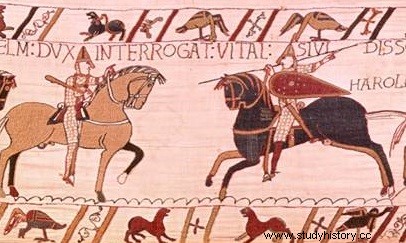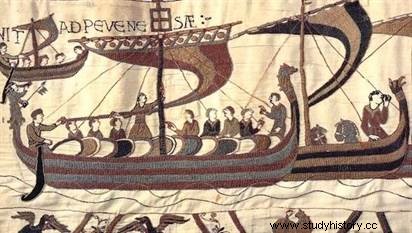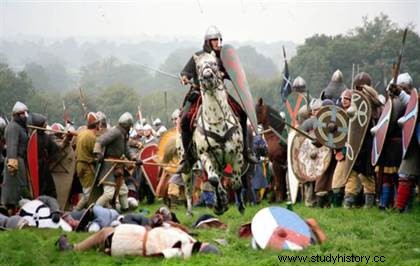 October 14, 1066 at the Battle of Hastings, William of Normandy wins a decisive victory over the troops of Harold II, Saxon king of England. Having become William I the Conqueror, the winner installed a Norman dynasty on the throne of England which would last a little less than a century. Founder of modern England, the battle of Hastings, one of the greatest in the medieval West, is also without doubt possible by its consequences on the construction of the two countries a major battle in the history of France, whose the adventures are reminded of us by the famous Bayeux tapestry.
October 14, 1066 at the Battle of Hastings, William of Normandy wins a decisive victory over the troops of Harold II, Saxon king of England. Having become William I the Conqueror, the winner installed a Norman dynasty on the throne of England which would last a little less than a century. Founder of modern England, the battle of Hastings, one of the greatest in the medieval West, is also without doubt possible by its consequences on the construction of the two countries a major battle in the history of France, whose the adventures are reminded of us by the famous Bayeux tapestry.
Behind the Battle of Hastings
Normandy in the second half of the 11th century was in the hands of William, Duke of Normandy and natural son of Robert the Magnificent (also known as "the devil"), born in 1027 Guillaume, nicknamed the “bastard”, had to fight for several years against the other pretenders to the Duchy of Normandy, and it was not until 1047 that he succeeded in establishing his authority over the barons. Normandy at that time was rich, densely populated and powerful. At the same time, on the other side of the Channel, the King of England, Edward the Confessor, died on January 5, 1066, without a son to succeed him. The day after the death, his brother-in-law, the Anglo-Saxon Earl Harold, seized the throne and had himself crowned King of England in York Cathedral, then the second largest city in the kingdom.
But William, Duke of Normandy, reacted immediately:Edward the Confessor, his cousin, made him his heir in 1051, a decision that Harold was responsible for officially announcing. . Guillaume therefore intends to take possession of his inheritance, including by arms. He begins by sending representatives to Rome. Harold having been guilty of perjury by having betrayed the promise made to King Edward, William manages to have him excommunicated and to obtain the support of Pope Alexander II to attack England. It is under the pontifical banners that William will cross the Channel.
Preparations for the Norman invasion
 Guillaume had ships built large enough and strong enough to embark not only soldiers but also horses, weapons and food. After several months of preparations, the fleet includes 1,400 ships, 400 for men and 1,000 for horses. Many volunteers, including lords and knights, show up to take part in the expedition. They come from different regions of France, even Italy, and are eager for adventure, new lands and spoils, while being reassured by the Pope's benevolence towards William's project. The latter thus constituted an army of nearly 7,000 men, including 2,000 horsemen.
Guillaume had ships built large enough and strong enough to embark not only soldiers but also horses, weapons and food. After several months of preparations, the fleet includes 1,400 ships, 400 for men and 1,000 for horses. Many volunteers, including lords and knights, show up to take part in the expedition. They come from different regions of France, even Italy, and are eager for adventure, new lands and spoils, while being reassured by the Pope's benevolence towards William's project. The latter thus constituted an army of nearly 7,000 men, including 2,000 horsemen.
The Channel crossing was delayed due to the lack of wind, then the storm, and it was only after a month and a half of waiting that they can cast off. On September 28, 1066, they finally set off and did not encounter any major obstacles during the crossing, Harold's fleet being blocked, in turn a victim of the wind. Harold finds himself in a particularly difficult situation, because just as William is about to disembark, another threat appears, this time on the North Sea:King Harald of Norway, also a relative of Edward the Confessor, wants to take over the crown to Harold. The latter, however, manages to beat the Norwegians at Stamford Bridge on September 25, 1066.
The Battle of Hastings
William's army lands on September 29 at Pevensey, on the Sussex coast. Determined to confront the English quickly, she won Hastings, while Harold's troops descended towards the south of the country. On September 13, the English arrived in the locality of Hastings and, seeing the Normans, settled on the hill. On the morning of September 14, the battle begins between the two armies whose numbers are equivalent. Quickly, the Normans realize that they cannot overcome the English, who benefit from a position in height and form with their shields an impassable hedge, in spite of the attacks of the archers and the horsemen.
 Guillaume then resorted to trickery:making his troops retreat to feign a retreat, he thus lowered the troops of Harold on the plain before launching his cavalry. The English, destabilized, defended themselves vigorously, but ended up losing hope when they learned of the death of their leader, Harold, shot in the head by an arrow. The English are forced to abandon their strategic position on Senlac Hill. Only a few groups of defenders escaped the assaults of the Norman cavalry at the end of the Battle of Hastings.
Guillaume then resorted to trickery:making his troops retreat to feign a retreat, he thus lowered the troops of Harold on the plain before launching his cavalry. The English, destabilized, defended themselves vigorously, but ended up losing hope when they learned of the death of their leader, Harold, shot in the head by an arrow. The English are forced to abandon their strategic position on Senlac Hill. Only a few groups of defenders escaped the assaults of the Norman cavalry at the end of the Battle of Hastings.
Consequences of the Norman victory at Hastings
At the end of the day, the Normans are victorious at Hastings. William the Conqueror was crowned King of England on December 25, 1066, in London's Westminster Cathedral. Over the next few years, he made England the richest and most powerful kingdom in Western Europe. However, as Duke of Normandy, William is also a vassal of King Philippe I of France. This situation is a source of serious tension and Guillaume must face the alliance of his eldest son, Robert de Courteheuse, with King Philippe.
In the summer of 1087, William was seriously injured during a confrontation with the King of France on French soil. He died the following September 7, in the city of Rouen, and was buried according to his wishes in the Abbey of Saint-Etienne-de-Caen. His second son, Guillaume le Roux, succeeded him on the throne of England and the Norman dynasty imposed itself permanently. From its powerful links with the kingdom of the Franks will emerge the seeds of the great rivalries of the following century until the Hundred Years War.
Bibliography
- Hastings:October 14, 1066, from Pierre Bouet. Tallandier, 2014.
- William the Conqueror:The Bastard Who Took England, by François Neveux. West France, 2020.
